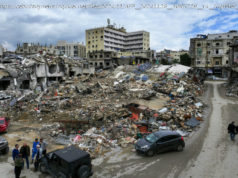Forecasters warn of a “life-threatening” storm surge as a stretch of coast from Louisiana to Alabama awaits the latest hurricane.
GULFPORT, Miss. — This year’s crushing hurricanes have submerged Houston, wrecked the Florida Keys and decimated Puerto Rico, but spared the central Gulf Coast — at least until now.
Hurricane Nate, the 14th named storm of the Atlantic hurricane season, gained strength on Saturday in the Gulf of Mexico and was speeding toward this low-lying stretch of coast, threatening to come ashore somewhere between New Orleans and Mobile, Ala., as a Category 2 storm, forecasters said.
The governors of Alabama, Florida, Louisiana and Mississippi declared states of emergency, and counties along the coast prepared for winds that the National Hurricane Center said could reach up to 105 miles an hour.
“Sooner or later, living here, you’re going to get hit,” said Rich Hazen, 52, of Diamondhead, Miss., as he stopped for a coffee, having already prepared his generator, cleared his yard and gathered drinking water ahead of the storm.
As Nate amassed power in the Gulf, the Hurricane Center issued hurricane warnings for the coast from Louisiana to Alabama. Some areas, including Mobile, Ala., could receive 6 to 10 inches of rainfall as the storm passes through, although forecasters said that a “life-threatening” storm surge — which could reach 7 to 11 feet in parts of Louisiana and Mississippi — and wind were likely to cause the biggest problems.
Gov. John Bel Edwards of Louisiana, said on Saturday afternoon that the storm was moving at “an extremely fast rate” of 26 miles an hour, which he said was “almost unheard-of for a storm of this type.”
With the storm moving so quickly, Mr. Edwards urged residents to get to safety by 3 p.m. Tropical-storm-force winds, or winds up to 73 m.p.h., he said, were expected at the mouth of the Mississippi River at 4 p.m. The eye of the storm was expected to make landfall in the same area around 7 p.m., which is when a curfew will take effect in New Orleans.
Even though its speed would limit the amount of time it could deluge any single place, Mr. Edwards said, “this is a very dangerous storm nonetheless.”
“It has proven to be very deadly in Honduras and Nicaragua and that area,” Mr. Edwards said. “We have to make sure we are not taking it lightly.”
The storm threatened the same stretch of coast that is, in many ways, still recovering from the destruction of Hurricane Katrina in 2005. At the 17th Street Canal between New Orleans and Metairie, La., workers from the Army Corps of Engineers lowered a set of enormous gates at the mouth of the canal. On Friday, divers checked the beds that the gates rest on to make sure that they would be able to close.
In 2005, there were no gates there or at the three other rainwater drainage canals in New Orleans. Katrina’s surge pushed water from Lake Pontchartrain deep into the canals. When levees along those canals breached, much of the city was inundated, and stayed underwater for weeks, until the breaches could be closed and the neighborhoods pumped dry. The Corps later acknowledged the hurricane protection system it built was “a system in name only.”
Now the Corps is building permanent pumping stations at the very end of these canals to help prevent flooding and to pump the rainwater out of the city. Until then, a structure of gates and temporary pumps has been built to protect nearby neighborhoods.
On Saturday afternoon, as Nate’s outer bands hit New Orleans, rain pounded the streets, pushed by heavy gusts. Pedestrians took off running or huddled under overhangs.
Nia Johnson, 23, who lives on Alvar Street a few dozen blocks from the Mississippi River, said that she and her family planned to pile into the car and drive to Lafayette, La., because the streets of her area “always flood.” The power would almost certainly go out because of the high winds, she said, leaving them unable to cook for days. “So we’re leaving,” she added.
Further east, in Biloxi, Miss., a casino city that lost 6,000 structures in Hurricane Katrina, officials urged residents to prepare for Nate as quickly as possible.
“We want to make sure our public knows that this is now forecast to be a Category 2 storm when it makes landfall, and it’s going to make landfall on the Mississippi Gulf Coast,” said Vincent Creel, the public affairs manager in Biloxi. “Our people have probably five, six hours to do whatever it is they need to do.”
If the storm does hit the Mississippi Gulf Coast, it will be the first storm to have done so since Katrina. But Mr. Creel said Hurricanes Harvey and Irma, which passed west and east of the area, had served as stark reminders of a hurricane’s havoc.
“It’s been to the left, to the right, and now right to us,” Mr. Creel said.
Still, there was an air of calm along the coast. Grocery stores had not yet run out of water and bread, and gas stations were not choked up with evacuees.
Merlin and Suzie DeCorte, of Metaire, La., stopped at the R & O restaurant for lunch with their son Jacob, 8, near the 17th Street Canal in New Orleans, all wearing Louisiana State University T-shirts.
“It didn’t seem like it was going to be that bad,” Ms. DeCorte said of the storm, although she said the jump to a Category 2 had given them an extra “air of caution.” They had more time, she said, to get away from the city if needed.
In Gulfport, Mr. Hazen and his wife, Dawn, were completing their afternoon errands with a decided sense of normalcy.
“Church hasn’t been canceled for this evening,” Ms. Hazen said.
“And Waffle House is still open,” Mr. Hazen said, citing the ever-reliable barometer of Southern disaster.
“If they close,” Ms. Hazen said, “then you know you’re in trouble.”






